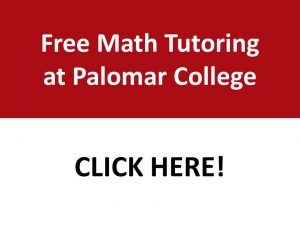Mathematics Program Student Learning Outcome: Recipients of our AS degree, in mathematics, will be well prepared to continue their education in STEM (Science, Technology, Engineering, Mathematics) at a college or university.
Math, Science, and Engineering Student Learning Outcomes
| Course | Student Learning Outcome (SLO) |
|---|---|
| Math 1 | Apply mathematical principles and techniques to solve problems in areas such as ancient systems of numeration, set theory and number theory. |
| Use critical thinking to arrive and conclusions from Venn diagrams, syllogistic forms and truth tables. | |
| Demonstrate knowledge of affective domain and study skills. | |
| Math 11 | Analyze and solve a precalculus level problem using analytic methods. |
| Sketch the graph of a precalculus level problem using skills beyond plotting a table of points. | |
| Demonstrate knowledge of affective domain and study skills. | |
| Math 13 | Recognize, apply, and interpret multiple representations (graphic, symbolic, numerical/data, verbal/applied) of integration and its applications. |
| Recognize, apply, and interpret multiple representations (graphic, symbolic, numerical/data, verbal/applied) of the derivative and its applications. | |
| Demonstrate knowledge of affective domain and study skills. | |
| Math 14 | Interpret slope as rate of change. |
| Use exponential growth and decay models to make predictions. | |
| Demonstrate knowledge of affective domain and study skills. | |
| Computational Skills: successful students will be proficient in arithmetic with integers, rational numbers, decimals and percents | |
| Math 20 | Construct and interpret graphs such as bar charts, histograms and box plots. |
| Compute appropriate descriptive statistics. | |
| Choose and apply inferential analyses in order to draw conclusions about a population. | |
| Demonstrate knowledge of affective domain and study skills. | |
| Math 50 | Solve linear equations: Students will be able to solve linear equations. |
| Math 100 | Critical thinking: use critical thinking to arrive at conclusions from Venn Diagrams, syllogistic forms, and truth tables. |
| Cultural understanding: relate a knowledge of the people, and uses of mathematics throughout history of mathematics. | |
| Principles and Technique: apply mathematical principles and techniques to solve problems in areas such as ancient systems of numeration, set theory, and number theory. | |
| Math 101 | Interpret slope as a rate of change. |
| Use exponential growth and decay models to make predictions. | |
| Math 105 | Place Value: students will demonstrate an understanding of place value by counting in bases other than base ten |
| Math 106 | Area and Perimeter: students will be able to demonstrate an understanding of the difference between area and perimeter. |
| Math 110 | College Algebra: students will be able to analyze and solve a precalculus level problem using analytic methods and be able to sketch the graph of a precalculus level function. |
| Math 115 | Applications of Right Triangle Trigonometry: use trigonometric functions to solve application problems involving unknown sides of right triangles |
| Trigonometric Equations: be able to solve equations involving trigonometric functions | |
| Trigonometric function values: analytically evaluate the six trigonometric functions of angles of measures that are multiples of 30 degrees and 45 degrees. | |
| Trigonometric Identities: use basic identities to verify trigonometric identities or to simplify trigonometric expressions. | |
| Math 120 | Descriptive statistics: compute appropriate descriptive statistics. |
| Graphing: students will be able to construct and interpret graphs such as bar charts, histograms and box plots. | |
| Inferential statistics: choose and apply inferential analyses in order to draw conclusions about a population. | |
| Math 126 | Students will be able solve multi-step precalculus level problems in a variety of contexts related to science, technology, engineering, and mathematics |
| Students will be able use multiple representations of functions to interpret and describe how two quantities change together. | |
| Math 127 | Students will be able to create sinusoidal models and interpret the period, amplitude, vertical shift and phase shift in the context of STEM applications. |
| Students will be able to use multiple representations of functions to interpret and describe how two quantities change together. | |
| Students will be able to solve trigonometric equations. | |
| Math 130 | Interpret derivative: students will recognize, apply, and interpret multiple representations (graphic, symbolic, numerical/data, verbal/applied) of the derivative and its applications. |
| Interpret Integration: students will recognize, apply, and interpret multiple representations (graphic, symbolic, numerical/data, verbal/applied) of integration and its applications. | |
| Math 135 | Graph functions: demonstrate proficiency in the graphing of functions at the precalculus level. |
| Solve equations: solve equations involving algebraic and transcendental functions at the precalculus level | |
| Math 140 | Antiderivative: find the antiderivative of a function using basic integration rules. |
| Limits: evaluate limits analytically. | |
| Optimization: use calculus to solve optimization problem | |
| Rules of Derivatives: find the derivative of a function using rules of derivatives | |
| Math 141 | Integration Techniques: demonstrate proficiency in evaluating integrals using various techniques of integration. |
| Math 146 | Functions, Subroutines: develop a FORTRAN-90 program that contains functions and subroutines. |
| Sequence, Selection, Iteration: develop a FORTRAN-90 program that contains sequence, selection and iteration control structures | |
| Math 200 | Demonstrate understanding of the theoretical foundations of linear algebra, such as vector spaces, inner product spaces, the eigenvalue problem. May include applications from math, science, or engineering. |
| Solve a linear system using appropriate methods and interpret the results. | |
| Math 205 | Multivariable Functions: perform calculus on multivariable functions. |
| Vector Operations: perform vector operations using geometry in space. | |
| Vector Valued Functions: Perform calculus on vector valued functions | |
| Math 206 | Application of Differential Equations: successful students will be able to compare first- and second-order differential equations, solve these equations using appropriate techniques including constructing solutions using series and matrices, and apply them to problems in science and engineering. |
| Math 245 | Mathematical Proofs: prove a statement using one of the basic methods of proof or disprove it using a counter example. |
| Minimum Spanning Tree: Use a standard algorithm to find a minimal spanning tree for a given graph. |



